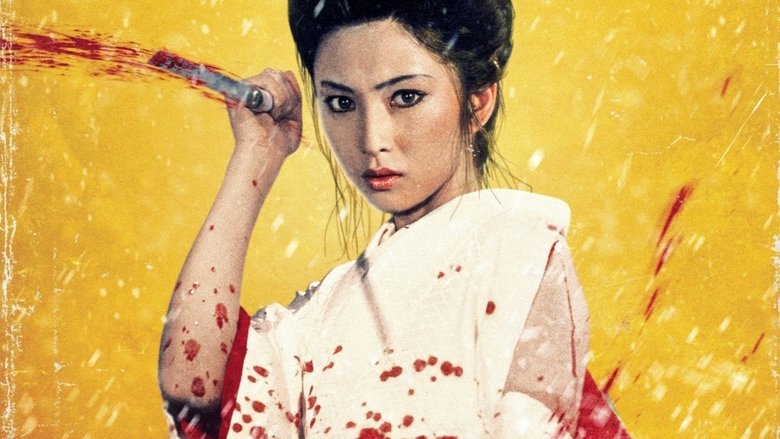← Back to Reviews

in
#442 - Lady Snowblood
Toshiya Fujita, 1973

When her quest for revenge against a gang of murderous thieves is prematurely halted by her imprisonment, a widow conceives a daughter who will finish her quest off for her.
It's no surprise that Quentin Tarantino "steals from every movie ever made" in his own words, but in the case of Lady Snowblood his tendency towards affectionate homage becomes especially pronounced. This is no slam against the film itself, but it does mean you have to consciously apprecite the film on its own terms, which is almost besides the point when it comes to getting lost in a film. Lady Snowblood does compensate for any imitations for rising above its apparent genre limitations. After its convoluted set-up that ambitiously involves flashbacks within flashbacks explaining not only its protagonist's back-story but also her deceased mother's back-story, the protagonist then gets started on taking down the remaining members of the gang that pre-emptively wronged her. I've talked before about how revenge movies have started to bore me in recent times, but I never got that particular feeling with Lady Snowblood. It helps that it does have a rather solid plot developing at a strong pace underneath its exploitational surface.
As for the action, well, it's used sparingly and the film is developed in such a way that it keeps from being boring even when it's not showing Lady Snowblood wreaking bloody vengeance on her foes. The action consists mostly of sword-fighting with the occasional spot of gun violence thrown in for good measure, which is all captured with some effective use of cameras and editing without much use for background score. and there is a degree of moral ambiguity to a lot of the violence perpetrated in this film (most obviously when it turns out that one of Snowblood's targets is now a miserable drunkard full of regret and whose only daughter must resort to sex work in order to pay for his habit). That at least promises to lend a bit of depth to the cartoonish geysers of blood that frequently erupt from characters that are mortally wounded. The setting also means that there are some interesting undertones of European imperialism (the finale takes place during a very French-looking masquerade party, for instance), while the film has twists that can be seen from a mile away but do little to lessen the entertainment. Though Lady Snowblood may not be quite as awesome as I'd have hoped, it is a fine example of a film that exceeds its exploitation-like standards and becomes a genuinely enjoyable film in the process.
Toshiya Fujita, 1973

When her quest for revenge against a gang of murderous thieves is prematurely halted by her imprisonment, a widow conceives a daughter who will finish her quest off for her.
It's no surprise that Quentin Tarantino "steals from every movie ever made" in his own words, but in the case of Lady Snowblood his tendency towards affectionate homage becomes especially pronounced. This is no slam against the film itself, but it does mean you have to consciously apprecite the film on its own terms, which is almost besides the point when it comes to getting lost in a film. Lady Snowblood does compensate for any imitations for rising above its apparent genre limitations. After its convoluted set-up that ambitiously involves flashbacks within flashbacks explaining not only its protagonist's back-story but also her deceased mother's back-story, the protagonist then gets started on taking down the remaining members of the gang that pre-emptively wronged her. I've talked before about how revenge movies have started to bore me in recent times, but I never got that particular feeling with Lady Snowblood. It helps that it does have a rather solid plot developing at a strong pace underneath its exploitational surface.
As for the action, well, it's used sparingly and the film is developed in such a way that it keeps from being boring even when it's not showing Lady Snowblood wreaking bloody vengeance on her foes. The action consists mostly of sword-fighting with the occasional spot of gun violence thrown in for good measure, which is all captured with some effective use of cameras and editing without much use for background score. and there is a degree of moral ambiguity to a lot of the violence perpetrated in this film (most obviously when it turns out that one of Snowblood's targets is now a miserable drunkard full of regret and whose only daughter must resort to sex work in order to pay for his habit). That at least promises to lend a bit of depth to the cartoonish geysers of blood that frequently erupt from characters that are mortally wounded. The setting also means that there are some interesting undertones of European imperialism (the finale takes place during a very French-looking masquerade party, for instance), while the film has twists that can be seen from a mile away but do little to lessen the entertainment. Though Lady Snowblood may not be quite as awesome as I'd have hoped, it is a fine example of a film that exceeds its exploitation-like standards and becomes a genuinely enjoyable film in the process.
